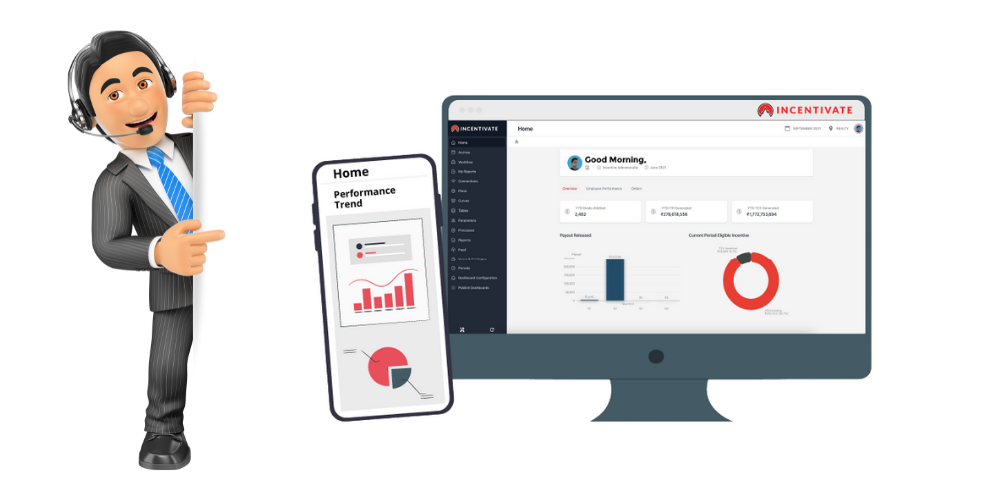Your sales team broke the records of making the most sales in this quarter. Everyone in the sales team performed well and surpassed their quota. Not just the number of successful sales increases, but the number of calls increased as well. However, even with such grand sales, there wasn’t much change in the revenue generated this year as compared to the previous. This is a case where your sales efficiency increased significantly but the sales effectiveness didn’t change much.
But what is sales effectiveness? And how is it different from sales efficiency? Shouldn’t more sales mean more revenue?
Not necessarily. Selling more doesn’t infer an increase in revenue as well. It depends on the kind of products being sold, their profit margins, how much effort is being placed in selling the products, and the strategies being followed. It is the responsibility of the sales leaders to guide their team in a direction that is best suited for achieving short-term and long-term business goals and not just racking up sales numbers. Measuring sales effectiveness is an important step in this journey and should be adopted by sales leaders as soon as possible.
What is Sales Effectiveness?
The sales team of an organization are responsible for selling multiple products and services to different customers. For this, they employ several different methods and strategies to get the most penetration and conversion. Sales effectiveness measures the efficacy or potency of these methods to see if the sales activities and numbers are helping the organization or not.
In an organization, the quantity of sales doesn’t matter that much as compared to the impact of the sale. Your sales team can successfully sell a million copies of a low-margin product but if your business objective was to increase margins and generate more revenue, those million sales hold little to no value. Sales effectiveness will give you a complete measurement of how your sales team is performing and whether they are meeting their goals or not.
A clear understanding of sales effectiveness is important to grow as an organization and drive more revenue. It highlights the areas where your organization is lacking and where they are performing exceptionally well so that you can create sales strategies that target these factors. While a robust marketing campaign and increasing awareness among the target audience matters, nothing is more important than sales for a business.
For businesses that want to improve their sales and onboard new customers, it is vital to keep an eye on your sales efforts. They can use the motivational power of incentives and variable compensation to encourage sellers to work hard and not only meet their targets but complete effective sales as well. There are several different metrics that a sales manager can use to evaluate their sales strategies and the sales team as well.
Sales Effectiveness Metrics Worth Measuring
Sales is a mixture of art and science and while art can differ from person to person and is very difficult to quantify, the science part can be measured easily and accurately. Here are a few metrics that will give you an insight into your sales effectiveness and areas for improvement as well.
1. Percentage of the Team Achieving Quota
Any organization would want the majority of its sales team to hit the quota or target regularly. However, this could have an inverse effect as well if it’s not managed correctly. For instance, if more than 90% of your sales team are able to achieve their quota every month, you might be losing money rather than being in profit. This means that the target is not challenging enough for the sales reps and they are able to achieve it easily. And since the quota is achieved, they tend to reduce their effort in generating more sales as well.
However, if the percentage of the sales team hitting their quota is too low, it can demotivate the entire team and damage their morale. If they feel like the targets are impossible to achieve, they can give up on the deals too quickly rather than fighting for them. This is why it is important to measure the percentage of your sales team that is able to achieve the quota as it helps in maintaining a competitive spirit among them.
2. Win/Loss Ratio
In the sales game, there are bound to be some losses as well. It is not possible for any sales rep to close every deal in the pipeline successfully, no matter how good their product or selling skills are. But a lost deal doesn’t just mean a loss of business opportunity, it can be considered as a learning experience for the sales reps and the sales team.
The win/loss ratio gives an analytical insight into how your sales strategies and sales reps are working and whether you are going in the right direction or not. If the win rate increases, it means that the sales rep has employed the correct sales strategy and that you’re moving in the correct direction. If the loss ratio increases, however, you can understand that either the sales strategy is not that effective or the sales rep is not putting in that much effort. Ineffective team members and sales strategies should be addressed quickly.

3. Deals by Lead Source
While there are customers that might come up to your directly to buy a product or service, most of your customers are converted from potential leads. Leads can come from different sources and make up the building block for future sales.
Thus, it becomes important for organizations to analyze lead sources closely. This will help you in directing the sales team to the most lead-generating territories and will also helo in allocating the marketing budget, improving sales forecasts, and also streamlining the sales efforts.
4. Percentage of Qualified Leads
Just like every lead won’t go on to become a successful sale, every lead is also not worth pursuing. This can be understood by the fact that some of the users visiting your website are not potential customers but are just there to gather information and maybe to write their own articles. It is hence important to analyze every lead and their intent so that qualified leads can be identified quickly and the sales team can work on them to close a deal.
5. Revenue from New Business vs Existing Customers
While it is important for any business to keep attracting new customers by selling their products and services, they need to keep their existing customers in check as well. Contacting and converting new leads is not only time-consuming but can be five to seven times more expensive as well.
Sales teams and managers should keep an eye on the revenue generated by new customers vs existing customers. A sustainable business is able to achieve a majority of its revenue from existing customers as they perform repeat business. However, if most of your revenue is coming from new customers, you might need to rethink your sales strategies and analyze why you are unable to retain customers and what is driving them to not do business with you again.
6. Your Most Important Customers
There is a Pareto principle that says that 80% of your output comes from just 20% of the work. This adage can be applied to the sales domain as well with 80% of your revenue coming from 20% of your customers. The actual split might change as per the business but the underlying theory remains the same and you should understand that only a select percentage of your customers are needed for doing a majority of the business.
It is essential to analyze who are those select customers, what are their demographics, and what makes them buy your products. This will give you an insight into where your marketing efforts should be targeted and how much money you need to spend to get the most business. This will also prevent you from spending a lot of money on a smaller demographic.
Importance of Measuring Sales Effectiveness
Measuring sales effectiveness can be an important aspect of a business and more than 65% of B2B organizations think of it as the #1 challenge. In a survey done by Vantage Point Performance, it was found that 44% of sales executives feel that their company is following ineffective methods to manage their sales pipeline.
An ineffective sales process can cost millions of dollars in revenue for businesses. Lost deals, delay in contacting leads, inaccurate management of sales team, and other factors can lead to businesses not achieving their targets regularly. In order to generate more revenue and close more deals, organizations need to improve their sales efforts and streamline processes. By measuring sales effectiveness thoroughly, they can get a clear understanding of different metrics that need to be worked on. It will also give them an idea of whether to change the sales strategy, add in more sales reps, expand the territories, discontinue a product, and more.
How to Improve Sales Effectiveness
Every business is different. Their target audience is different, the product is different, and the way they do sales is also different. Hence there isn’t a specific blueprint for improving the effectiveness of their sales efforts. However, there are a few points that are common across industries that can help businesses.
Identify the Correct Sales Process
First thing is to analyze if your existing sales process works or does it warrant some change. There is a saying that you can’t expect different things to happen while doing the same thing again and again. Sales leaders need to create a consistent sales process that works no matter the market scenario. Adapting to the market is a necessity for successful sales teams.
Provide Proper Training to the Sales Reps
Knowing what needs to be done and executing it are two different tasks. A sales representative can understand what a sales manager needs from him but without proper training and guidance, he might not know how to achieve it in the first place. Continuous training is important in the sales game as sales reps need to know what the best practices are for every scenario. Sales leaders can also help them with guidance and just-in-time coaching.
Adopt Clear Communication

Streamlining business processes and tracking the right metrics at the right time is extremely important for businesses that want to enhance the impact of their sales team. Incentivate helps in increasing the sales effectiveness of an organization by delivering important information about the sales team and process accurately and timely.
Incentivate is an end-to-end no-code platform for sales performance management, reporting, and analytics. It can be easily integrated with the ERP, CRM, HRMS, and other tools and software existing in the company and can gather data about the sales team from everywhere. With a 100% audit coverage and more than 75% faster change rollout, Incentivate can reduce the total cost of ownership to more than 70%.
By automating the sales commissions calculations, Incentivate helps businesses in shortening their execution times. It generates visual reports that interactively depict the processed metrics making it easier for sales leaders to read, understand, and implement in their sales teams. Businesses can configure it to manage performance curves and other parameters as per the needs and requirements of the business.
Incentivate automates the business processes for various roles, functions, and complexity for improving sales effectiveness across the entire organization. It fulfils compliance requirements and guidelines from several different international bodies and ensures that your data remains secure on the cloud, even if it’s resting or in transit.

